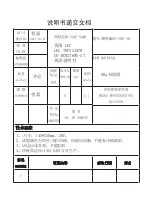
T-334
4--5
ing the PRE-TRIP key. The unit will then resume nor-
mal operation. If the user decides to terminate a test
but remain at the test selection menu, the user may
press the UP ARROW key. When this is done, all test
outputs will be de-energized and the test selection
menu will be displayed.
3. Throughout the duration of any pre-trip test (except
the P-7 high pressure switch tests), the current and
pressure limiting processes are active. The current
limiting process only is active for P-7.
d. Pre-Trip Test Results
At the end of the pre-trip test selection menu, the
message “P,” “rSLts” (pre-trip results) will be displayed.
Pressing the ENTER key will allow the user to see the
results for all subtests (i.e., 1-0, 1-1, etc). The results will
be displayed as “PASS” or “FAIL” for all the tests run to
completion since power up. If a test has not been run
since power up, “
-----
” will be displayed. Once all pre-test
activity is completed, dehumidification and bulb mode
must be reactivated manually if required.
4.9 OBSERVE UNIT OPERATION
4.9.1 Probe Check
If the DataCORDER is off or in alarm, the controller will
revert to a four-probe configuration which includes the
DataCORDER supply and return air probes as the
secondary
controller
probes.
The
controller
continuously performs probe diagnosis testing that
compares the four probes. If the probe diagnosis result
indicates a probe problem exists, the controller will
perform a probe check to identify the probe(s) in error.
a. Probe Diagnostic Logic - Standard
If the probe check option (controller configuration code
CnF31) is configured for standard, the criteria used for
comparison between the primary and secondary
control
probes is:
1C (1.8F) for perishable set points or 2C (3.6F) for
frozen set points.
If 25 or more of 30 readings taken within a 30 minute
period are outside of the limit, then a defrost is initi-
ated and a probe check is performed.
In this configuration, a probe check will be run as a part
of every normal (time initiated) defrost.
b. Probe Diagnostic Logic - Special
If the probe check option is configured for special, the
above criteria are applicable. A defrost with probe check
will be initiated if 25 of 30 readings or 10 consecutive
readings are outside of the limits.
In this configuration, a probe check will not be run as part
of a normal defrost, but only as part of a defrost initiated
due to a diagnostic reading outside of the limits.
c. The 30 minute timer will be reset at each of the follow-
ing conditions:
1. At every power up.
2. At the end of every defrost.
3. After every diagnostic check that does not fall out-
side of the limits as outlined above.
d. Probe Check
A defrost cycle probe check is accomplished by
energizing just the evaporator motors for eight minutes
at the end of the normal defrost. The probes will be
compared to a set of predetermined limits at the end of
the eight minute period. The defrost indicator will remain
on throughout this period.
Any probe(s) determined to be outside the limits will
cause the appropriate alarm code(s) to be displayed to
identify which probe(s) needs to be replaced. The
P5 Pre-Trip test must be run to inactivate alarms.
4.10 SEQUENCE OF OPERATION
General operation sequences for cooling, heating and
defrost are provided in the following subparagraphs.
Schematic representation of controller action are
provided in Figure 4--3 and Figure 4--4. Refer to Section
3 for detailed descriptions of special events and timers
incorporated by the controller in specific modes of
operation.
4.10.1 Sequence of Operation - Compressor Phase
Sequence
The controller logic will check for proper phase
sequencing and compressor rotation. If sequencing is
allowing the compressor (and three--phase fan motor, if
equipped) to rotate in the wrong direction, the controller
will energize or de--energize relay TCP as required (see
Figure 4--5). Relay TCP will switch its contacts,
energizing or de--energizing relays PA and PB. Relay
PA is wired to energize the circuits(s) on L1, L2 and L3.
Relay PB is wired to energize the circuit(s) on L3, L2,
and L1, thus providing reverse rotation.
Downloaded from
















































